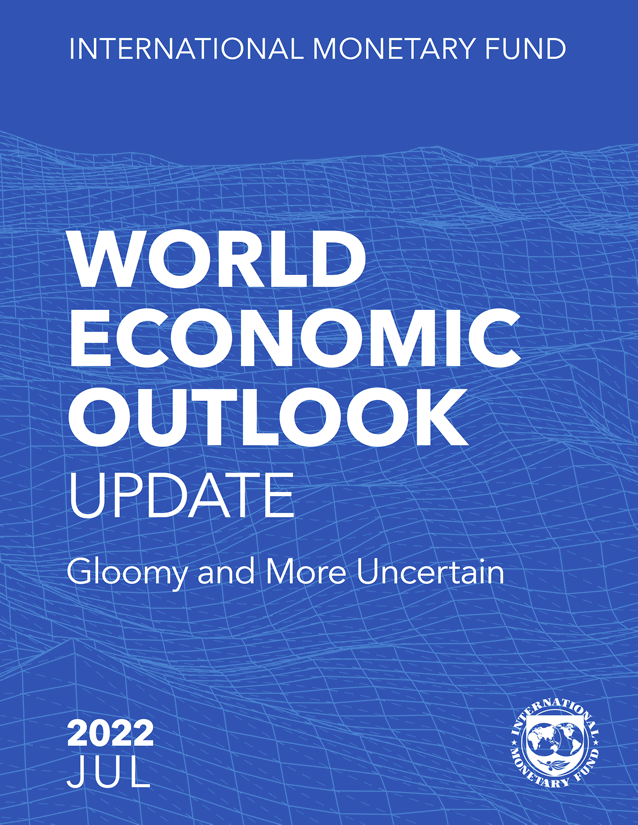« Droupadi Murmu takes Oath as the 15th President of India; Becomes the Country's first Tribal President. | Main | The United International Baseball League creates the first-ever professional baseball league to serve India, Pakistan, and the Middle East. »
July 26, 2022
IMF (International Monetary Fund) publishes World Economic Outlook July 2022

Washington, DC, July 26, 2022 — IMF today published its World Economic Outlook for July 2022. The outlook for global growth has grown “gloomy and more uncertain,” the IMF’s chief economist Pierre-Olivier Gourinchas warned.
Increasingly gloomy developments followed tentative recovery in 2021 in 2022 as risks began to materialize. Global output contracted in the second quarter of this year, owing to downturns in China and Russia, while US consumer spending undershot expectations. In addition, several shocks have hit a world economy already weakened by the pandemic: higher-than-expected inflation worldwide—especially in the United States and major European economies—triggering tighter financial conditions; a worse-than-anticipated slowdown in China, reflecting COVID- 19 outbreaks and lockdowns; and further negative spillovers from the war in Ukraine.
“The outlook has darkened significantly since April. The world may soon be teetering on the edge of a global recession, only two years after the last one. Multilateral cooperation will be key in many areas, from climate transition and pandemic preparedness to food security and debt distress. Amid great challenge and strife, strengthening cooperation remains the best way to improve economic prospects for all and mitigate the risk of geo-economic fragmentation,” Gourinchas said at the launch of the quarterly update of the IMF’s World Economic Outlook report.
The Fund is warning that elevated inflation, rising interest rates, a high US dollar valuation, the impact of the war in Ukraine, and a slowdown in Chinese growth are all factors leading to a downward revision in the forecast.
“In particular, a full shutdown of Russian gas flows to Europe or inflation pressures remaining more elevated than they’ve been in the past. And we’ve been repeatedly surprised by the persistence and the broadening of inflation in recent times and an increase in financial tightening around the world. And so if you put all these things together, we get a global economy, as I mentioned in my remarks, that gets close to 2% in 2023, where we think a lot of the vulnerabilities are where you have a lot of slowdown happening. And so 2% is a low number for the global economy. So that’s a sense in which we’re getting close, really close to a global recession,” he explained.
Persistent high inflation in the US and other big economies is leading central banks to hike interest rates. Meanwhile, there is a move to the safety of the US dollar, which means that emerging markets are especially hit with higher prices while also seeing the cost of servicing their debt increase. As a result, the temptation will be to push off reforms or to raise spending, but the Fund says that action now will head off more pain later.
“What is important here is that, in a sense, there is one overwhelming priority at this point: to bring back price stability in advanced economies and emerging markets. Many of them have seen elevated price pressure, whether we are in the baseline or whether we are in the alternative scenario. And in the alternative scenario, inflation pressures are pushing even higher, and there’s even more of a need for central banks and policymakers to address that issue. And this is critical because it’s necessary to plant the seed for future macroeconomic stability. So a stable macroeconomic environment requires that we bring down inflation in the coming year, year-and-a-half,” he answered.
Gourinchas also said there is still a path to a ‘soft landing’ in the US, meaning that the Federal Reserve can head off a recession through calibrated action.
“The current environment suggests that the likelihood that the US economy can avoid a recession is quite narrow. Under our current projections, for instance, for the US, the quarter… Q4 on Q4 growth rate in 2023 is only 0.6%. And 0.6%, that’s under our baseline. So you see, a small shock at this point could be enough to sort of knock off the US economy of a fairly low number and tilt it into recession. So it’s a very narrow, it’s a very narrow path at this point,” Gourinchas remarked.
Source: IMF (International Monetary Fund)
|GlobalGiants.Com|
— The editor holds certification in “Financial Market Analysis” from International Monetary Fund, Washington, DC.
IMF Growth Projections: 2022
— IMF (@IMFNews) July 26, 2022
USA🇺🇸: 2.3%
Germany🇩🇪: 1.2%
France🇫🇷: 2.3%
Italy🇮🇹: 3.0%
Spain🇪🇸: 4.0%
Japan🇯🇵: 1.7%
UK🇬🇧: 3.2%
Canada🇨🇦: 3.4%
China🇨🇳: 3.3%
India🇮🇳: 7.4%
Russia🇷🇺: -6.0%
Brazil🇧🇷: 1.7%
Mexico🇲🇽: 2.4%
KSA🇸🇦: 7.6%
Nigeria🇳🇬: 3.4%
RSA🇿🇦: 2.3%https://t.co/ldMsaieJUU pic.twitter.com/Ip06Wct3s4







Edited & Posted by the Editor | 9:04 PM | Link to this Post







